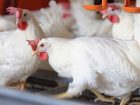
A&W’s egg policy puzzle
By Treena Hein
Features Companies Profiles Alternative poultry housing Animal Welfare Egg productionCompany struggles with promise to source free-run, antibiotic-free poultry products.
 Susan Senecal (second from left), A&W’s president and COO, says the consumer response to the company’s egg policies has been positive.
Susan Senecal (second from left), A&W’s president and COO, says the consumer response to the company’s egg policies has been positive. In September 2014, A&W Foodservices of Canada announced itself as the first national quick service restaurant chain in North America to serve eggs from hens fed a vegetarian diet. A month later, the chain became the first in North America to serve chicken Raised Without the use of Antibiotics (RWA). In terms of the response to the chicken and egg campaigns, Susan Senecal, the chain’s chief marketing officer at the time and now president and chief operating officer, stated in late 2014 that, “Canadians are voting with their stomachs and the response has been fabulous.”
Senecal went on to say that “in September 2013, we became the first national fast-food restaurant to serve beef raised without the use of hormones or steroids and our guests loved it,” she says. “We then began asking what other changes they would like to see, and guests told us very clearly that how their chicken and eggs are raised and produced is very important to them.”
When asked why A&W is choosing to promote eggs from hens fed vegetarian diets when chickens are actually natural omnivores who will eat plant matter as well as insects, snails and so on if foraging outdoors for themselves, Senecal again focuses on customers. “They told us they would rather have eggs from hens fed a vegetarian diet without animal by-products and we agreed,” she says. “Our chickens are fed a diet of wheat, corn, soy meal and vegetable oil as well as some probiotics and prebiotics.”
Then on March 10, 2016, A&W announced a major commitment to become the first national quick service restaurant in Canada to serve eggs from hens raised in ‘better’ cage-free housing. According to the company press release, it expected to achieve this lofty goal by March 2018.
At this point, all of the company’s eggs are sourced from RWA hens in enriched housing on a vegetarian diet. “Currently, there are no open-barn housing options available in Canada that meet A&W’s volume needs and also allow for an antibiotic-free environment,” Senecal says. “Based on information and science made available to us, we feel that enriched housing is the best opportunity for ensuring hen welfare, worker welfare and food safety. With the growing interest in cage-free eggs, we believe it’s critical to find a cage-free solution that does not require the use of antibiotics while maintaining our existing standards.”
Backing up to the March 2016 press release, the company also announced it was giving a sizable grant to Farm & Food Care Canada (now called the Canadian Centre for Food Integrity) to help develop new housing options that were inline with its RWA standard. However, at the time, Farm & Food Care Canada released the following statement to clarify about acceptance and possible use of this money: “Contrary to media reports, Farm & Food Care Canada will not be funding research into finding better cage-free housing alternatives for hens…In its press release, A&W stated the following: ‘As a part of its commitment to improving egg laying hen housing, a $100,000 A&W grant is being made to Farm & Food Care Canada… With this investment, the organization will bring together industry experts from many fields to help build on existing work and set better direction for hen housing in Canada.’
“Farm & Food Care Canada was approached for this work earlier this week as a third-party coordinator to host a session to bring egg industry partners, retail and food service from across Canada together with the US Center for Food Integrity’s Coalition for a Sustainable Egg Supply.
“The principle of the discussion would be to broaden it beyond hen welfare to include all issues impacting sustainable eggs including food safety, environment, hen health, worker health and safety and food affordability and determine areas that the Canadian egg sector felt this funding would be best spent. No agreements have been or will be signed for the funding or its terms until after the Farm & Food Care Canada board of directors and egg industry partners have discussed best options.”
Senecal explains, “As a part of our commitment to continuously improve animal welfare, we put forward seed money of $100,000…in 2016 to potentially build on existing work and find a [cage-free] solution that will benefit Canadians, egg farmers and the food industry. We have had interest expressed in various sectors and are hopeful about making an announcement about this initiative in the near future.”
Crystal Mackay, CEO of the Canadian Centre for Food Integrity, says “nothing has been decided at this point,” and “we do not have the funds at this time.”
Research into cage-free, antibiotic-free production and Ontario
Dr. Elijah Kiarie explains that laying hens are not “big users” of antibiotics and that treatment of them with antibiotics takes place only under veterinary prescription. “Arguably, caging them negated any need of antibiotics for growth/performance promotion, as such housing separated them with litter and excreta contamination,” Kiarie, who is the assistant professor and McIntosh Family Professorship in Poultry Nutrition in the department of Animal Biosciences at the University of Guelph, says.
Kiarie believes placing laying hens on littered floors and cage-free environments will definitely be problematic, particularly in terms of proliferation of gut pathogens. “Although my preliminary assessment indicates the egg industry has done excellent engineering to ensure manure belts are in use in cage-free housing, variation occurs across the systems,” the expert notes. “This is a new frontier in terms of research.”
Professor Billy Hargis, director of the JKS Poultry Health Laboratory and Tyson Endowed Chair for Sustainable Poultry Health in the faculty of poultry science at the University of Arkansas, explains that in terms of hens receiving antibiotics under veterinary prescription, “we know that egg yolks accumulate antibiotics very effectively, and that a yolk starts forming about seven or eight days before the egg is laid – the withdrawal period after antibiotic use would be very long. The egg producer will have lost a lot of value for those birds for the production cycle, and it would likely make much more sense economically to cull the flock if a sizable number of hens needed antibiotics. Good management is really important.”
He says pullets are able to receive antibiotics unless the eggs they produce as adults are going to carry a label that claims ‘no antibiotics ever.’ “Gut health challenges in chickens occur,” he adds, “mostly when birds are young.”
Kiarie and his team are trying to understand the impact of long-term feeding of probiotics to pullets through to laying. Research on this is currently underway by a post-doctoral scientist in Kiarie’s lab. He also has a graduate student evaluating strategies for reducing crude protein in layer diets by using synthetic amino acids, and another student looking at functional properties of alternative protein sources such as insect meal, to partly or wholly replace soybean meal. “We see the amount and type of protein in layer diets is a big issue,” he says, “which could upset gut microbiota and ammonia emissions in cage-free environment.”
Print this page

